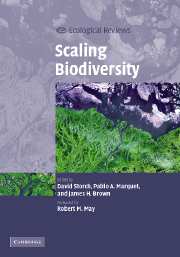Book contents
- Frontmatter
- Contents
- List of contributors
- Foreword by Robert M. May (Lord May of Oxford)
- Preface
- 1 Introduction: scaling biodiversity – what is the problem?
- PART I Spatial scaling of species richness and distribution
- PART II Alternative measures of biodiversity: taxonomy, phylogeny, and turnover
- PART III Scaling of biological diversity with energy and the latitudinal biodiversity gradient
- 11 Climate and diversity: the role of history
- 12 Inverse latitudinal gradients in species diversity
- 13 Regional-to-global patterns of biodiversity, and what they have to say about mechanisms
- 14 Recasting the species–energy hypothesis: the different roles of kinetic and potential energy in regulating biodiversity
- 15 Scaling species richness and distribution: uniting the species–area and species–energy relationships
- PART IV Processes, perspectives, and syntheses
- Index
- Plate section
- References
12 - Inverse latitudinal gradients in species diversity
Published online by Cambridge University Press: 05 August 2012
- Frontmatter
- Contents
- List of contributors
- Foreword by Robert M. May (Lord May of Oxford)
- Preface
- 1 Introduction: scaling biodiversity – what is the problem?
- PART I Spatial scaling of species richness and distribution
- PART II Alternative measures of biodiversity: taxonomy, phylogeny, and turnover
- PART III Scaling of biological diversity with energy and the latitudinal biodiversity gradient
- 11 Climate and diversity: the role of history
- 12 Inverse latitudinal gradients in species diversity
- 13 Regional-to-global patterns of biodiversity, and what they have to say about mechanisms
- 14 Recasting the species–energy hypothesis: the different roles of kinetic and potential energy in regulating biodiversity
- 15 Scaling species richness and distribution: uniting the species–area and species–energy relationships
- PART IV Processes, perspectives, and syntheses
- Index
- Plate section
- References
Summary
Introduction
No single pattern of biodiversity has attracted ecologists more than the observed increase in species richness from the poles to the tropics (Pianka, 1966; Rohde, 1992; Rosenzweig & Sandlin, 1997; Gaston & Blackburn, 2000; Willig, Kaufman & Stevens, 2003; Hillebrand, 2004). An obstacle in the search for the primary cause of this latitudinal gradient is the ever-increasing number of hypotheses (Pianka, 1966; Rohde, 1992; Clarke, this volume), their interdependence (Currie, 1991; Gaston & Blackburn, 2000) and lack of rigorous falsification (Currie, Francis & Kerr, 1999; Currie, this volume). However, a general decline in species richness with latitude is commonly observed (Pielou, 1977; Colwell & Hurtt, 1994; Willig & Lyons, 1998; Colwell & Lees, 2000; Zapata, Gaston & Chown, 2003; Colwell, Rahbek & Gotelli, 2004).
Some groups of organisms, however, show an opposite trend: a strong latitudinal decline in species diversity towards the tropics. These trends have been almost neglected in the literature and little is known about their underlying ecological and evolutionary causes. Therefore, the ecological explanations proffered are usually specific to the group in question. Here an account of the most important cases of inverse latitudinal gradients is given. The existing hypotheses explaining this phenomenon are summarized and the evidence that tends to favor one of these is presented.
- Type
- Chapter
- Information
- Scaling Biodiversity , pp. 246 - 257Publisher: Cambridge University PressPrint publication year: 2007
References
- 38
- Cited by



